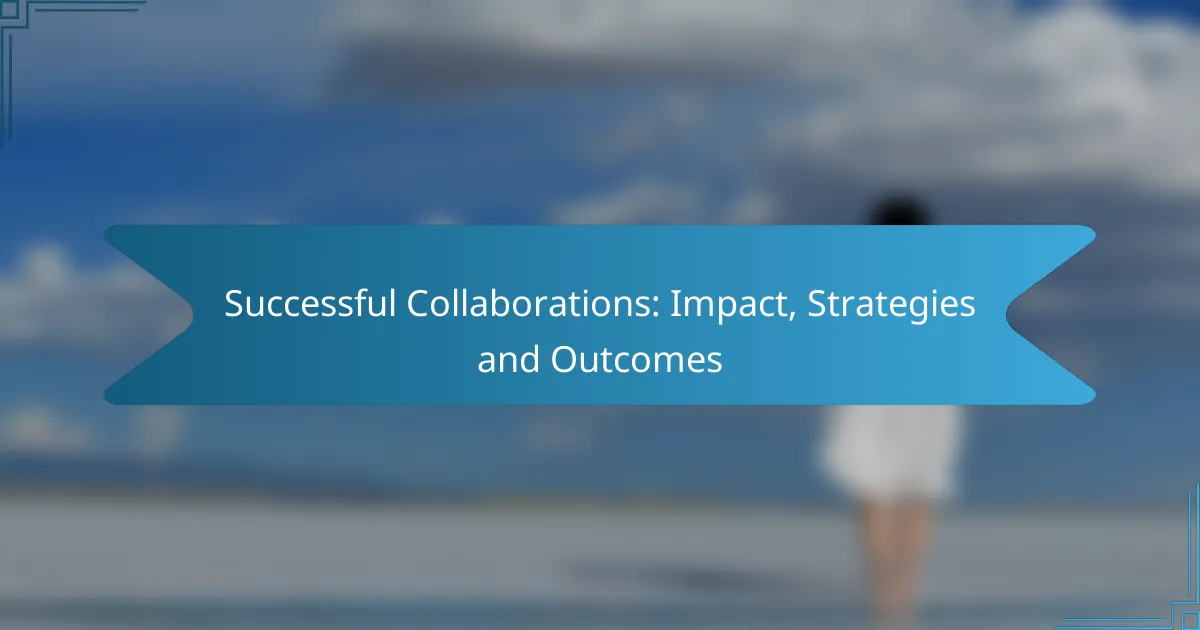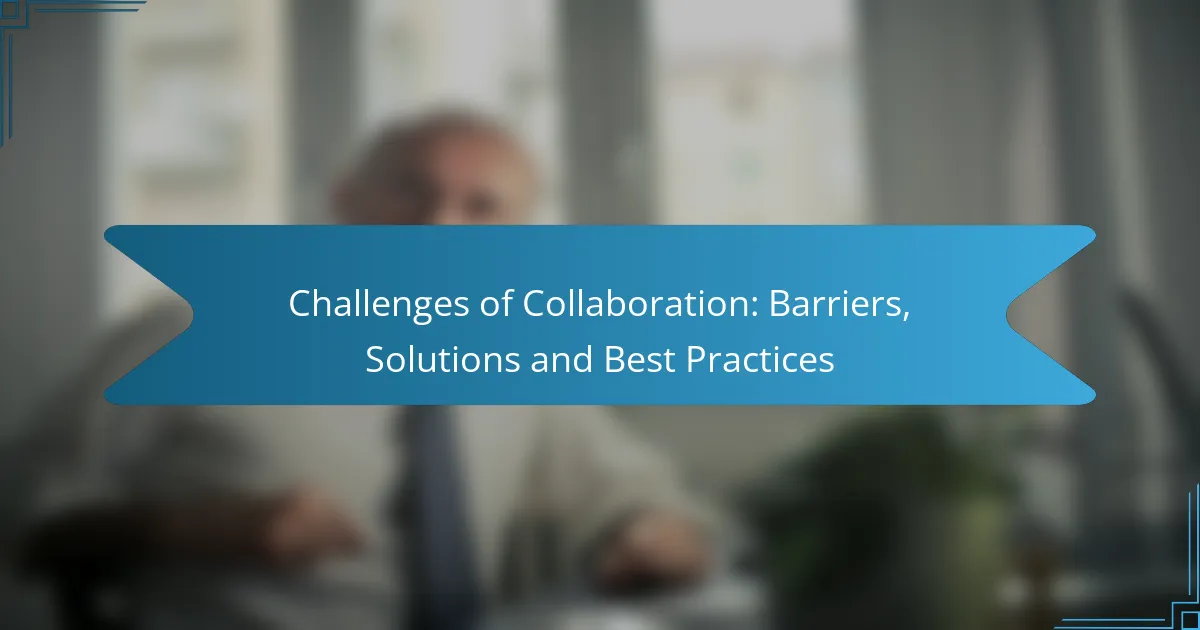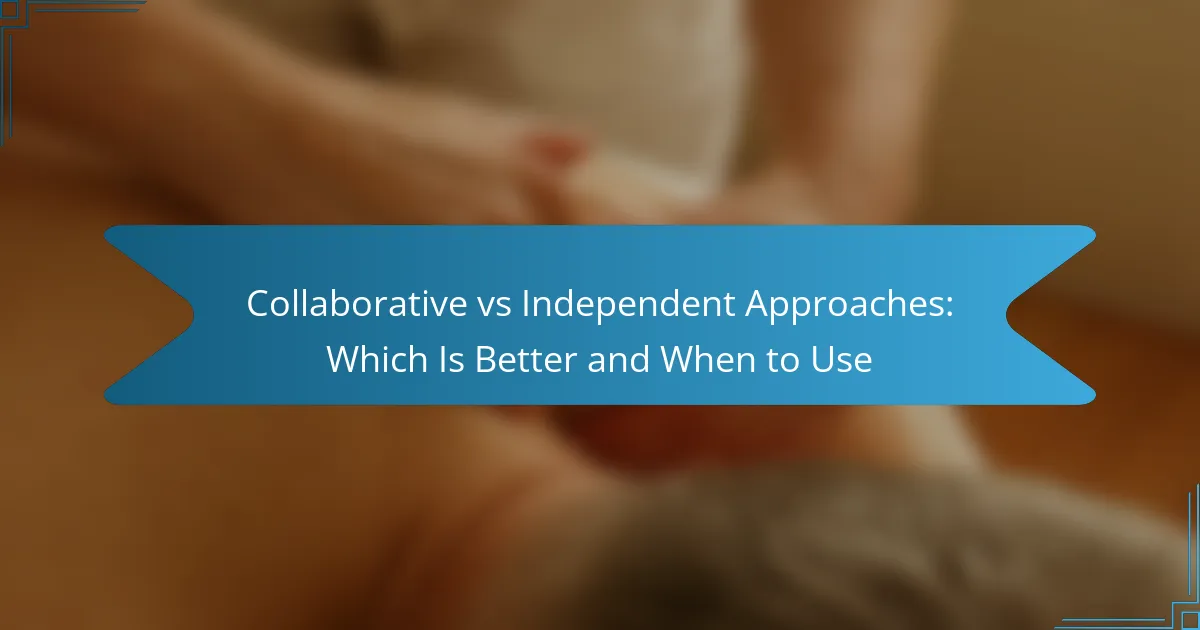Successful collaborations are vital for enhancing organizational performance, driving innovation, and improving resource sharing. By implementing effective strategies such as setting clear objectives and fostering open communication, teams can achieve remarkable outcomes. Emphasizing best practices like structured agreements and ongoing feedback ensures that all members are aligned and actively contributing to shared goals.

What Are the Key Benefits of Successful Collaborations?
Successful collaborations yield numerous advantages that can significantly enhance organizational performance. These benefits include increased innovation, enhanced resource sharing, improved market reach, stronger relationships, and higher success rates.
Increased innovation
Collaborations often lead to increased innovation by combining diverse perspectives and expertise. When teams from different backgrounds work together, they can generate creative solutions that may not emerge in isolated environments.
For example, a tech company partnering with a design firm can produce cutting-edge products that blend functionality with aesthetics. This cross-pollination of ideas can result in unique offerings that stand out in the market.
Enhanced resource sharing
Successful collaborations enable organizations to share resources effectively, reducing costs and maximizing efficiency. By pooling resources such as technology, talent, and capital, partners can achieve more than they could independently.
For instance, two startups might share office space and administrative services, allowing them to focus on their core business activities while minimizing overhead expenses. This shared approach can lead to significant savings and improved operational capabilities.
Improved market reach
Collaborations can significantly enhance market reach by leveraging each partner’s networks and customer bases. This expanded access allows organizations to tap into new demographics and geographical areas more effectively.
For example, a local brand collaborating with a well-established international company can gain instant credibility and visibility in foreign markets. This strategic alignment can lead to increased sales and brand recognition.
Stronger relationships
Working together fosters stronger relationships between organizations, which can lead to long-term partnerships. These relationships are built on trust, communication, and shared goals, creating a solid foundation for future collaborations.
Regular interactions and joint projects can help partners understand each other’s strengths and weaknesses, facilitating smoother cooperation in subsequent endeavors. Strong relationships can also lead to referrals and additional opportunities.
Higher success rates
Collaborative efforts often result in higher success rates for projects and initiatives. By combining resources and expertise, partners can mitigate risks and enhance the likelihood of achieving their objectives.
A study of joint ventures indicates that those with strong collaborative frameworks tend to outperform their competitors. Organizations that embrace collaboration can significantly increase their chances of success in various ventures, from product launches to market expansions.

How to Develop Effective Collaboration Strategies?
Developing effective collaboration strategies involves setting clear objectives, ensuring open lines of communication, utilizing appropriate technology, and nurturing a collaborative environment. These elements work together to enhance teamwork and drive successful outcomes.
Define clear goals
Establishing clear goals is essential for effective collaboration. Goals should be specific, measurable, achievable, relevant, and time-bound (SMART). This clarity helps all team members understand their roles and responsibilities, aligning their efforts towards a common purpose.
For example, instead of a vague goal like “improve sales,” a clear goal would be “increase sales by 15% over the next quarter.” This specificity provides a target for the team to aim for and facilitates accountability.
Establish open communication
Open communication is crucial for fostering collaboration. Encourage team members to share ideas, feedback, and concerns freely. Regular check-ins and updates can help maintain transparency and ensure everyone is on the same page.
Utilizing tools like instant messaging platforms or regular video calls can enhance communication. Avoid common pitfalls such as relying solely on emails, which can lead to misunderstandings or missed messages.
Leverage technology tools
Technology tools can significantly enhance collaboration by streamlining processes and improving accessibility. Consider using project management software, document sharing platforms, and communication apps to facilitate teamwork.
For instance, tools like Trello or Asana can help track project progress, while Google Drive allows for real-time document collaboration. Choose tools that fit your team’s needs and ensure everyone is trained to use them effectively.
Foster a collaborative culture
Creating a collaborative culture involves promoting teamwork and encouraging a sense of community among team members. Recognize and reward collaborative efforts to reinforce this culture.
Encourage team-building activities and open discussions to strengthen relationships. Avoid fostering a competitive environment, as it can hinder collaboration and lead to disengagement. Instead, focus on shared successes and collective problem-solving.

What Are the Best Practices for Collaboration in the UK?
The best practices for collaboration in the UK focus on clear communication, structured agreements, and ongoing feedback. These strategies help teams work effectively together, ensuring that everyone is aligned and contributing to shared goals.
Regular check-ins
Regular check-ins are essential for maintaining momentum in collaborative efforts. Scheduling weekly or bi-weekly meetings allows team members to discuss progress, address challenges, and adjust plans as needed.
During these check-ins, it’s beneficial to set a clear agenda and encourage participation from all members. This ensures that everyone has a voice and that issues are addressed promptly, fostering a more cohesive team environment.
Document agreements
Documenting agreements is crucial for clarity and accountability in collaboration. This includes recording decisions made during meetings, outlining roles and responsibilities, and establishing timelines for deliverables.
Using shared digital platforms can streamline this process, allowing all team members to access and refer to the documents easily. Clear documentation helps prevent misunderstandings and provides a reference point for future discussions.
Encourage feedback
Encouraging feedback is vital for continuous improvement in collaborative projects. Create an open environment where team members feel comfortable sharing their thoughts on processes and outcomes.
Implementing regular feedback sessions or anonymous surveys can help gather insights and suggestions. This practice not only enhances team dynamics but also leads to better decision-making and project outcomes.

What Tools Facilitate Successful Collaborations?
Successful collaborations rely on effective tools that enhance communication, project management, and document sharing. Utilizing the right platforms can streamline processes, improve team dynamics, and lead to better outcomes.
Slack for communication
Slack is a popular messaging platform designed for team communication. It allows users to create channels for different topics, making it easy to organize discussions and keep relevant conversations together.
To maximize Slack’s effectiveness, set clear guidelines for channel usage and response times. Encourage team members to use threads for specific discussions to avoid cluttering main channels.
Be mindful of notification settings to prevent overload, and consider using integrations with other tools to centralize updates and information.
Trello for project management
Trello is a visual project management tool that uses boards, lists, and cards to help teams track tasks and progress. Each card can represent a task, and users can move them through different stages of completion.
To get the most out of Trello, define clear workflows and assign responsibilities for each card. Utilize labels and due dates to prioritize tasks and keep everyone accountable.
Regularly review boards during team meetings to assess progress and adjust plans as necessary. This ensures that all team members stay aligned on project goals.
Google Drive for document sharing
Google Drive is a cloud-based storage solution that facilitates easy document sharing and collaboration. It allows multiple users to access and edit files in real-time, which enhances teamwork and reduces version control issues.
When using Google Drive, organize files into clearly labeled folders to simplify navigation. Set appropriate sharing permissions to control who can view or edit documents, ensuring sensitive information remains secure.
Encourage team members to utilize comments and suggestions features for feedback, which can streamline the review process and foster collaborative input.



